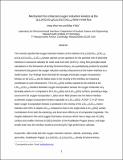Mechanism for enhanced oxygen reduction kinetics at the (La,Sr)CoO3−δ/(La,Sr)2CoO4+δ hetero-interface
Author(s)
Han, Jeong Woo; Yildiz, Bilge
DownloadHanYildiz Manuscript Revised_3.pdf (769.6Kb)
OPEN_ACCESS_POLICY
Open Access Policy
Creative Commons Attribution-Noncommercial-Share Alike
Terms of use
Metadata
Show full item recordAbstract
The recently reported fast oxygen reduction kinetics at the interface of (La,Sr)CoO3−δ (LSC113) and (La,Sr)2CoO4+δ (LSC214) phases opened up new questions for the potential role of dissimilar interfaces in advanced cathodes for solid oxide fuel cells (SOFCs). Using first-principles based calculations in the framework of density functional theory, we quantitatively probed the possible mechanisms that govern the oxygen reduction activity enhancement at this hetero-interface as a model system. Our findings show that both the strongly anisotropic oxygen incorporation kinetics on the LSC214 and the lattice strain in the vicinity of the interface are important contributors to such enhancement. The LSC214(100) surface exposed to the ambient at the LSC113/LSC214 interface facilitates oxygen incorporation because the oxygen molecules very favorably adsorb onto it compared to the LSC214(001) and LSC113(001) surfaces, providing a large source term for oxygen incorporation. Lattice strain field present near the hetero-interface accelerates oxygen incorporation kinetics especially on the LSC113(001) surface. At 500 °C, 4 × 102 times faster oxygen incorporation kinetics are predicted in the vicinity of the LSC113/LSC214 hetero-interface with 50% Sr-doped LSC214 compared to that on the single phase LSC113(001) surface. Contributions from both the anisotropy and the local strain effects are of comparable magnitude. The insights obtained in this work suggest that hetero-structures, which have a large area of (100) surfaces and smaller thickness in the [001] direction of the Ruddlesden–Popper phases, and larger tensile strain near the interface would be promising for high-performance cathodes.
Date issued
2012-05Department
Massachusetts Institute of Technology. Department of Nuclear Science and Engineering; Massachusetts Institute of Technology. Laboratory for Electrochemical InterfacesJournal
Energy & Environmental Science
Publisher
Royal Society of Chemistry
Citation
Han, Jeong Woo, and Bilge Yildiz. “Mechanism for Enhanced Oxygen Reduction Kinetics at the (La,Sr)CoO3−δ/(La,Sr)2CoO4+δ Hetero-Interface.” Energy & Environmental Science 5, no. 9 (2012): 8598.
Version: Author's final manuscript
ISSN
1754-5692
1754-5706